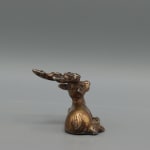Scythian Deer Figurine, 600-400 BCE
Gilt Bronze
Height: 4.4cm
Height: 1 3/4 inches
Length: 6.1cm
Length: 2 1/2 inches
Height: 1 3/4 inches
Length: 6.1cm
Length: 2 1/2 inches
EL.0047
Further images
The term “Scythian” has been used broadly to designate several distinct early nomadic groups which inhabited Eurasia, especially those who shared common characteristics with the “true” Scythians, such as similar...
The term “Scythian” has been used broadly to designate several distinct early nomadic groups which inhabited Eurasia, especially those who shared common characteristics with the “true” Scythians, such as similar weapons, equipment for horses, and art. The “true” Scythians (also sometimes called “Classical Scythians” or “Pontic Scythians”) were a nomadic people who had their origins in eastern Iran and migrated to the Pontic Steppe (in modern-day Ukraine and Southern Russia), occupying that area from around the 7th century to the 3rd century BC. They have been characterised as a warlike people who carried out frequent raids on surrounding populations. They were accomplished horsemen, whose main weapons were bows and arrows. They kept herds of horses, cattle, and sheep, and some became semi-nomadic on the Pontic steppe and practised more settled farming. The Scythians were involved in trade routes which were precursors to the Silk Road, and these may have offered the opportunity for the knowledge of metalworking to be transferred from the populations of Iran and China.
Metalworking became an important part of Scythian culture; it was necessary for their weapons, as well as for the creation of jewellery (which was worn by both men and women) and small decorative objects. Archaeological sites thought to have been occupied by the Scythians have revealed traces of workshops and other remnants of metalworking such as slag (a by-product of metallurgical processes such as smelting). Scythian art is characterised by its focus on animal motifs, as well as its tendency to favour portable objects because of the Scythians’ nomadic way of life. The interest in animals was probably also linked to the lifestyle of the Scythians, as they would have interacted with animals, both domesticated and wild, frequently.
This magnificent deer lies on its side, with three legs curled up to its right, and its front left leg raised above the ground. Its head is raised, with open mouth, alert eyes, and pricked ears. It seems almost as if it is ready to rise from its resting position to respond to some danger or intrusion into its peaceful habitat. The surface is decorated with intricate incised lines to mark the details of its coat and hooves, and there is a spiral shape on its right shoulder. Ripples in the metal show the folds of skin around its neck. Scythian representations of deer often have looped antlers. This artwork instead represents the antlers as straight lines adorned with additional shapes; each has two circular protrusions with dots in the centre, and a triangular shape at the end with two lines inside. This figurine beautifully captures the magnificence and elegance of the deer.
Metalworking became an important part of Scythian culture; it was necessary for their weapons, as well as for the creation of jewellery (which was worn by both men and women) and small decorative objects. Archaeological sites thought to have been occupied by the Scythians have revealed traces of workshops and other remnants of metalworking such as slag (a by-product of metallurgical processes such as smelting). Scythian art is characterised by its focus on animal motifs, as well as its tendency to favour portable objects because of the Scythians’ nomadic way of life. The interest in animals was probably also linked to the lifestyle of the Scythians, as they would have interacted with animals, both domesticated and wild, frequently.
This magnificent deer lies on its side, with three legs curled up to its right, and its front left leg raised above the ground. Its head is raised, with open mouth, alert eyes, and pricked ears. It seems almost as if it is ready to rise from its resting position to respond to some danger or intrusion into its peaceful habitat. The surface is decorated with intricate incised lines to mark the details of its coat and hooves, and there is a spiral shape on its right shoulder. Ripples in the metal show the folds of skin around its neck. Scythian representations of deer often have looped antlers. This artwork instead represents the antlers as straight lines adorned with additional shapes; each has two circular protrusions with dots in the centre, and a triangular shape at the end with two lines inside. This figurine beautifully captures the magnificence and elegance of the deer.













